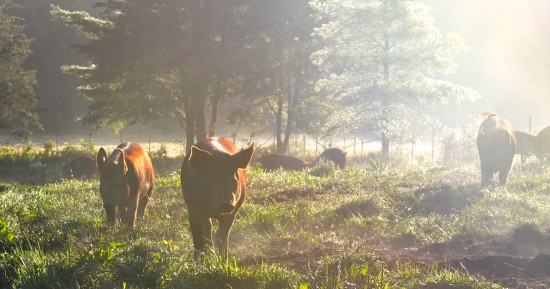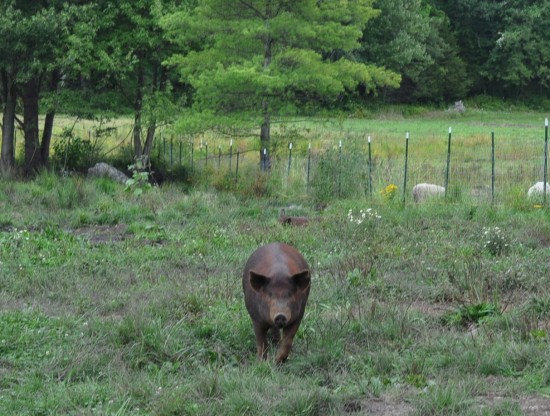Robb and I have become great friends over the last few years, bonding over nutrition, sustainability, and sometimes, moonshine. I recently asked him what was going on with the Liberty Gardens section of the website and he admitted that he needed “someone” to take it on. Well, I’m going to give a stab at it. I’ll be posting occasionally about my farm life, and if you have something you’d like to add, email us and we’ll try to get your story up here, too.
We paleo folks love our pork chops and bacon, but do you know where yours come from? As a farmer and paleo nutritionist, I’d love to point out how pork from pasture-raised pigs is not only better for you, but better for the pigs, the land, and public health. Plus, it tastes so good! And if you’d like to learn more about how we raise our pigs, check out the video at the end, and get my book, The Homegrown Paleo Cookbook, which is a paleo cookbook AND full homesteading guide so you can learn what goes into growing healthy food. Oh, and the foreword was written by Robb!
1. Better Tasting Pork. Sunshine, Grass & Low Stress – The Recipe for Perfect Pork. Say goodbye to flavorless, dry and anemic looking pork. Pasture raised pork is richer tasting. Each breed tastes different, and the flavor differs depending on what the pigs have eaten. Once you try it, you’ll never want to eat CAFO (Concentrated Animal Feeding Operation) pork again. Pastured pork does cook faster than conventionally raised pork, so searing the outside of cuts like chops, then transferring to the oven to finish is your best bet. Low and slow techniques like braising are also great with pastured pork.
2. More Nutritious Pork. Pigs raised on pasture have 300 percent more vitamin E and 74 percent more selenium (a vital antioxidant) in their milk than pigs raised in confinement, according to Don C. Mahan Professor of Animal Sciences at Ohio State University. This bounty of nutrients promotes healthier litters, shorter farrowing times, and good milk let down. Pastured pigs raised outdoors can also have more Vitamin D (read all about Vitamin D here, from the brilliant Chris Masterjohn) in the lard. Loren Cordain cites three studies on his website for the following quote: “Because pigs are monogastric animals (single stomach), they have the ability to convert vegetable and plant 18 carbon fatty acids (ALA) to the 20 and 22 carbon fatty acids (EPA and DHA) which reduce inflammation, reduce cardiovascular disease and promote good health for us all when we eat pork. Free ranging pork contains higher concentrations of these beneficial fatty acids than are found in their feed lot produced counterparts.” Additionally, there are no unnecessary antibiotics or growth stimulators given to organic, pasture-raised pork.
3. Happier Pigs. You likely have seen the images from films that illustrate CAFO conditions. Crowding, artificial lights, and a steady diet of soy and corn all lead to a very stressful life. A large CAFO building holds up to 2,500 sows or 10,000 market hogs, according to the Environmental Protection Agency. Their end-of-life is also not always as humane as it could be. Small farmers who raise their pigs using organic standards must offer pigs access to the outdoors shade, shelter, exercise areas, fresh air, and direct sunlight suitable to the species. Farmers who go the extra mile and become Animal Welfare Approved have even stricter standards when it comes to treatment and humane slaughter. Additionally, pasture-raised pork is generally a heritage breed pig. When you support producers that use these older breeds, you are preserving them for the future. This is important because when we lose a pig breed, it’s lost forever.
4. Better for the Land, and Taxpayers. A lot of unmanageable waste in the form of animal manure is created from CAFO farming. As it sits in large piles or in lagoons, it spills into surface and groundwater. This causes high levels of nitrogen and pathogens, and contributes to fish kills and “dead zones” in areas like the Gulf of Mexico. Furthermore, the CAFOs have been indirectly supported by taxpayer-subsidized feed grain thanks to the farm bill, which enables them to keep the prices of their meat artificially low. According to a report from the Union of Concerned Scientists, “indirect grain subsidies to CAFOs between 1997 and 2005 amounted to almost $35 billion, or nearly $4 billion per year, serving to entrench the CAFO system. CAFOs produce some 300 million tons of untreated manure each year (about twice as much as is generated by the entire human population of the United States).” Small farmers absorb the cost of clean environmental measures, making the playing field unfair when consumers are shopping for meat based on price alone.
5. Healthier For Society. A recent open access study showed that drug resistant bacteria (livestock-associated S. aureus, multidrug-resistant S. aureus and methicillin-resistant S. aureus) was carried in the nasal passages and on skin of industrial hog farm workers for up to 14 days. Yikes! This is dangerous not only to the farm workers themselves, by increasing the rate at which they succumb to drug-resistant infections, but also their families, local schools, and the greater communities. A recent WIRED article sites two other studies pointing to an almost three times higher risk of carrying MRSA from living near a Mega-Farm. Buying pasture-raised pork from farmers who use organic and sustainable techniques means they are less likely to be dealing with manure lagoons and the other sickening conditions that lead to the use of routine antibiotics. Another study divided a herd of pigs that had not been exposed to antibiotics for 126 months into two groups and either housed on pasture or in standard indoor units. Over a 20-month period, fecal coliforms from both groups of pigs were tested for resistance to standard antibiotics. Samples taken from the pastured pigs were far less likely to be antibiotic resistant.
Want to learn more about how we raise pigs on pasture at our farm? Check out my husband Andrew talking all things pig here:
Ready to find a local farmer to get some great pasture raised pork from? Check out eatwild.com and localharvest.org for farmers near you. No farmers near you and you still want this amazing pork? Ok, check out US Wellness Meats. The pork they sell does get some corn and soy (most farmers will feed pigs some grain), but it’s from small farms and the pigs are outdoors.
Want to see more images and learn more about my farm? Visit my blog, preorder my pretty and informative new book, and I’d be thrilled if you would follow me in Instagram, Facebook, Twitter, YouTube, and subscribe to my podcast, Sustainable Dish. Thanks for reading!
Cheers,
Diana



I can’t agree enough with this article. Its really important to educate people on what really goes on in commercial agriculture. If you want real food make sure you get it straight from the farmer. Take the time and find someone in your area that is raising your meat on pasture. If you are in baltimore area check me out my website http://www.primepasturefam.com
scott
Thank you. Watching the video made me both happy and sad. You can tell there is great care and responsiblity in how these animals are being raised.
Thanks for pointing out that pasture-raised pork has a better taste than traditional farm-raised pork. You also mention that pasture-raised pork is more nutritious since they have 300 percent more vitamin E. I think it’s important to choose pasture-raised pork since it is more humane than eating pork from a pig that has been held in a small container and fed foods that will do nothing but make it bigger, faster.
That too!
Hi! Believe me, I in now way want to bash or undermine your article. Mainly I am confused. I read the Ohio State report and no where there did I read anything pointing that pastured pigs contain more nutrients than conventionally-raised. His whole point was that pigs absorb organic (as opposed to in-organic) forms of selenium and Vit E, better. It does not appear that he wrote his report to convince the pig industry that pigs need more access to sunlight and natural foraging opportunities. And in the article on Vitamin D, pork is not found in the list of high vitamin D foods. I wanted to use these studies in a post I’m writing, but don’t feel I can accurately make those claims about pastured pork having a higher nutrient profile! If you would let me know if I’m missing something, that would be so appreciated. I still believe pastured pork is healthier for the other reasons cited!
I raise grass fed Tamworth hogs on free range pasture in the Pacific Northwest. Thank you for putting this article together and getting the word out!
I do not eat pork because the Bible says we are not port at all.Pigs do not sweat so all the cool reason it’s in their body stays there.
Would love to find some pasture-raised Tamworth pork. Been wanting to try it.
I can’t tell you how happy I am to see an article promoting pastured pork WITH CITATIONS!!! It is all too common for the permaculture community to make big claims with nothing but experience to back it up, but I really how thorough and well researched this article is. I am using some of your references for an analytical chemistry project comparing the degree of saturation in lard from pastured pigs vs pigs raised in confinement. Thank you!!!